Breast Cancer and Running: Heidi’s Story

Heidi (in sunglasses) running in the Charlottesville Women’s 4 Miler on Aug 31 (17 days after her last dose of chemo!) with her daughter Grace and her nephew’s fiance.
During this week, our Motherlode of Miles week that benefits the Donna Foundation, we are profiling four #motherrunners whose lives have been changed by breast cancer; hopefully the perspective and ideas they share will benefit others who are going through similar situations.
We’re starting with Heidi Gillenwater from Charlottesville, Virginia, who has four kids (ages 23, 20, 15, and 13.)
These posts are in their own words; they will also be guests on the AMR podcast at the end of this week.
Date of diagnosis: March 4, 2019
Type of breast cancer: Stage 2, invasive infiltrating ductal carcinoma, ER/PR positive, HER2 negative
Running through it: My treatment started with surgery: lumpectomy on April 4, 2019. I took 2 weeks off from running completely after surgery. I eased back into running again after this 2-week break but then had to take another little break when I got my porta cath.
I did my first post-chemo run two days after my first chemo. I continued to run throughout my chemotherapy treatment which started May 8 and ended Aug 14. (I received dose-dense adriamycin and cytoxan every 2 weeks for 4 cycles, then taxol every 2 weeks x 4 cycles.)
The thing that I noticed most with running while on receiving chemotherapy was that my heart rate became elevated out of proportion to my perceived level of exertion. For example, the run felt easy, but before I knew it, my heart rate was in the high 160’s or 170’s. This was very unusual for me.
Because of this, I used heart rate as my guide rather than perceived effort. I completely forgot about pace. I managed this by running until I noticed my heart rate drift into the high 150’s or low 160’s and then I would take a walk break until I recovered into the 130’s again.
I noticed that later in the cycle (when I was getting closer to being due for another cycle of chemo) I was able to run for longer stretches without walking.
I know that there are probably a lot of reasons for these observations with my running. Some are likely just deconditioning due to the break required after surgery. But I also got progressively more anemic with each cycle of chemo. And I know that the chemo was messing with all of my cells, not just the potential cancer cells that may be trying to lurk in the corners.
I started radiation on Sept 9. I am now able run continuously without my heart rate elevating into the 160’s. I am starting to gradually increase my mileage again and this feels so good.
Throughout all of this time, I have been going to a local treadmill studio where are there are different workouts that incorporate running and strength. After recovering completely from surgery, I felt that I had no limitations with strength work, and because of that, I feel that I have never been stronger. I have some serious strong glutes now.

Heidi and her family, just before her chemo started.
How breast cancer changed her running perspective: Although I have been running for a long time, probably over 30 years, I have been laser-focused on trying to qualify for Boston for the past six years. Through this process of trying to be the best runner I could be I learned a lot of things.
I learned that to get the most out of training, there must be a careful balance of focused high quality running, easy running, good nutrition, and self-care that includes quality sleep and general stress management. I needed every bit of these past six years to learn this.
I was registered to run the Sugarloaf Marathon in May of this year when I was diagnosed with breast cancer. I could feel deep in my soul that my body was finally really responding to all of the training and I was getting faster. My initial reaction to the timing of my breast cancer diagnosis was that it seems so unfair. I was very angry.
When I got over those emotions though I realized that these skills—nutrition, sleep, stress management, listening to my body—that took me six years to learn were exactly the skills that I needed to put my body in the best state to benefit from my treatment.
Who knew that I was not really training to be a better runner, but actually to be the best patient I could be?
Best thing she did for herself during treatment: Meditation has become a daily ritual. I have been using Headspace mostly, but occasionally I am able to meditate without guidance. Today my headspace app told me that I have meditated 100 days in a row. But I have really only missed probably 5-6 days since my diagnosis.
Best thing her friends/family did during treatment: Honestly, my biggest fear around having this diagnosis was being perceived by others as being sick. I don’t feel sick, and don’t want to be treated as if I am not well. I have appreciated every who treats me the same that they always did.
I just started publishing a public blog. This is something that has been sitting on my laptop until I had more courage (and time) to get it out there. I plan to include more details about my experience with exercise while on treatment as well as summarizing data from studies that have studied exercise in cancer patients while on treatment.
#382: Real Runners Share Stories of DNF’ing
 Sarah and Tish get real with three mother runners about pulling a DNF (Did Not Finish) in a race. The conversation includes:
Sarah and Tish get real with three mother runners about pulling a DNF (Did Not Finish) in a race. The conversation includes:-advice on how to handle stepping out of a race due to injury or mental-monkeys;
-starting-line suggestions for boosting finish-line success;
-ways to overcome the “sadness and embarrassment” of not finishing a race;
-suggestions for getting in the right race mindset from been-there, run-that BAMRs.
Go to ThirdLove.com/amr to find your perfect-fitting bra—and get 15% off your first purchase!
Homer creates a personalized learn-to-read plan for your kids ages 2-8: Visit LearnWithHomer.com/amr to start a free 30-day trial.
From 5Ks to ultras, use RaceRaves to find your next race. Go to RaceRaves.com
Dry Martini: Racing on a Whim and an Otter
To quote the great sage Ferris Bueller: “Life moves pretty fast. If you don’t stop to look around once in a while, you could miss it.”
When your life revolves around the academic calendar — my husband and I both work at SUNY Oneonta — the last few weeks of August are nutty. Most years, that nuttiness is complicated by our kids going back to school, too.
This year had other plans. The high school was a construction zone all summer. It would continue to be one a couple of days into the school year. The kids wound up with bonus days off; I wound up with extra days of couch slugs.
In the middle of all of the August upheaval, I had zero plans to run a 5K. And, yet, because of a dog musher in Wisconsin and my love of otters, I found myself on the starting line of a race in Old Forge three weeks ago.
To make a long story slightly less so: one of my most favorite twitter-ers is Blair Braverman. I was glued to her feed (and to that of the #uglydogs, which is kind of like a fan club and kind of like a chaotic force for good) during Braverman’s rookie Iditarod in March. During my obsessed refreshing of the feed for updates, I noticed that she has quite a few fans who are also runners. One of them, Jennifer, lives further upstate than I but has roots near where I live.
Of course, I followed her, too, if only because her dog looks a lot like my dog.
Near the end of August, she posted the medals for the Old Forge marathon, half-marathon, 10K, and 5K. She was running the half and would earn a moose. The bear medal caught my eye but I quickly realized that even though I have been known to make whimsical running choices, jumping into a marathon is a super bad idea.

You know you want one.
I do love otters, however, and a change of scenery would be refreshing.
A couple of computer clicks later and I had a 5K entry. A couple of clicks after that, I had a hotel room, because I did not want to get up before dawn to drive to the starting line. One phone call later, I had my best non-running friend as my wing-woman for the trip. Her August had been even more stressful than mine.
I didn’t have to break out the hard sell to convince her to be the Cameron to my Ferris. We even took her car. It is not a Ferrari.
Despite having lived here for more than 15 years, I’ve never really spent much time in the Adirondacks. At most, I’ve driven through them to get to Canada or Vermont. That is a poor decision on my part, as it turns out. Old Forge is charming. I’m plotting a family trip back this summer, should all of the stars align. I’m thinking a cabin on a lake, a gallon of bug spray, and a stack of books is all I’ll need. The rest of the family can sort themselves out.
If they ask nicely, I’ll share my bug spray.

Yes, I did go sit out on the pier for a bit.
The chill vibe extended to the race itself, so much so that it was hard to figure out where the starting line actually was. Maybe 100 racers — across all four races, mind — and about two dozen dogs moseyed around the rec center’s lawn. The half and full marathoners were rounded up, given a few instructions, and sent out into the woods. Fifteen minutes later, the rest of us took off after them.
The weather was ideal. Chilly but not freezing. Gray but not gloomy. Given that I’d jumped into the race just as the boarding doors were closing, I had zero expectations. All that I wanted was a very small adventure and that medal.
Rather than hold back during the first mile, I just took off. I felt pretty good when the second mile came around and kept the hammer down. We transitioned from snowmobile trail to trail-trail. Hopping over puddles was more fun than it should have been. Once we emerged from the trees, it was back down the paved road to the start. I pulled a Sarah and just emptied the tank.

This is my serious racing face.
According to Herr Garmin III, I finished in 34 minutes with an 11:12 mile average, which is pretty dang zippy for me. While that pace is pleasing, what matters more is how I felt. It was the most fun I’d had in running shoes for weeks. That makes all the difference.
I got my otter at the end. I also got an unanticipated apple cider donut and a break from the routine. What more could anyone want?
Have you ever jumped into a race at the last minute? What pulled you in?
AMR Gears Up: Race Day Essentials: Team Relay Races
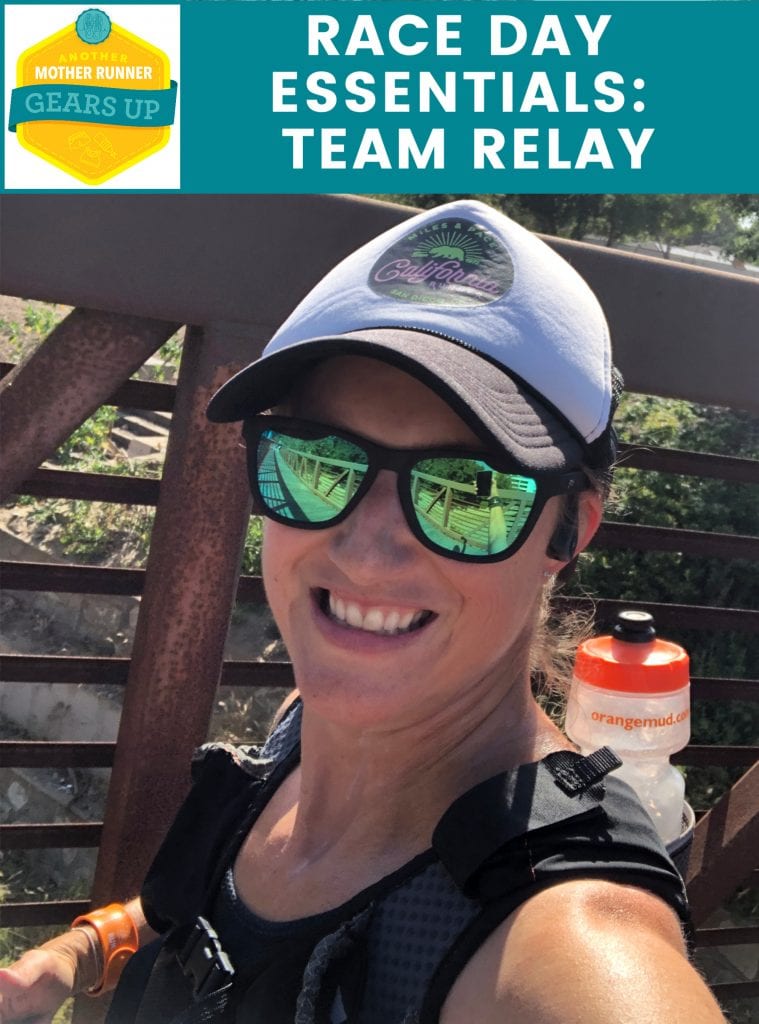
Welcome to a new series on Another Mother Runner: Race Day Essentials.
We’ve already covered favorite gear for the 5K/10K; half marathon; marathon; the ultra; and a sprint triathlon.
Today, Jenn Gill, who has run a variety of both trail and road Ragnar relays and is the coach in the Train Like a Mother relay programs, talks us through her favorite gear she uses to run three legs over 24 or so hours.
“Packing for a relay is one of the most stressful things a mother runner can do—well, running-related stress, that is,” she says, “With multiple runs, time in between, time in a van or tent, you want to make sure you bring everything you need for the relay adventure without overpacking!”
Here are her top essential items for any road or trail relay:
 OUTFITS PACKED IN ZIPLOC BAGS
OUTFITS PACKED IN ZIPLOC BAGS
1) it compresses the clothes and items so they don’t take too much space in my gear bag,
2) I can make sure I haven’t left any essential item out for each run as pack before the relay
and
3) I can place the worn, stinky, sweaty clothes back into the Ziploc so my clean clothes aren’t corrupted. So I pack 3 Ziplocs for 3 runs and then a 4th with an extra running outfit just in case. I have often needed to run an extra run for an injured teammate or just wanted to run a little extra to see more of the relay course.
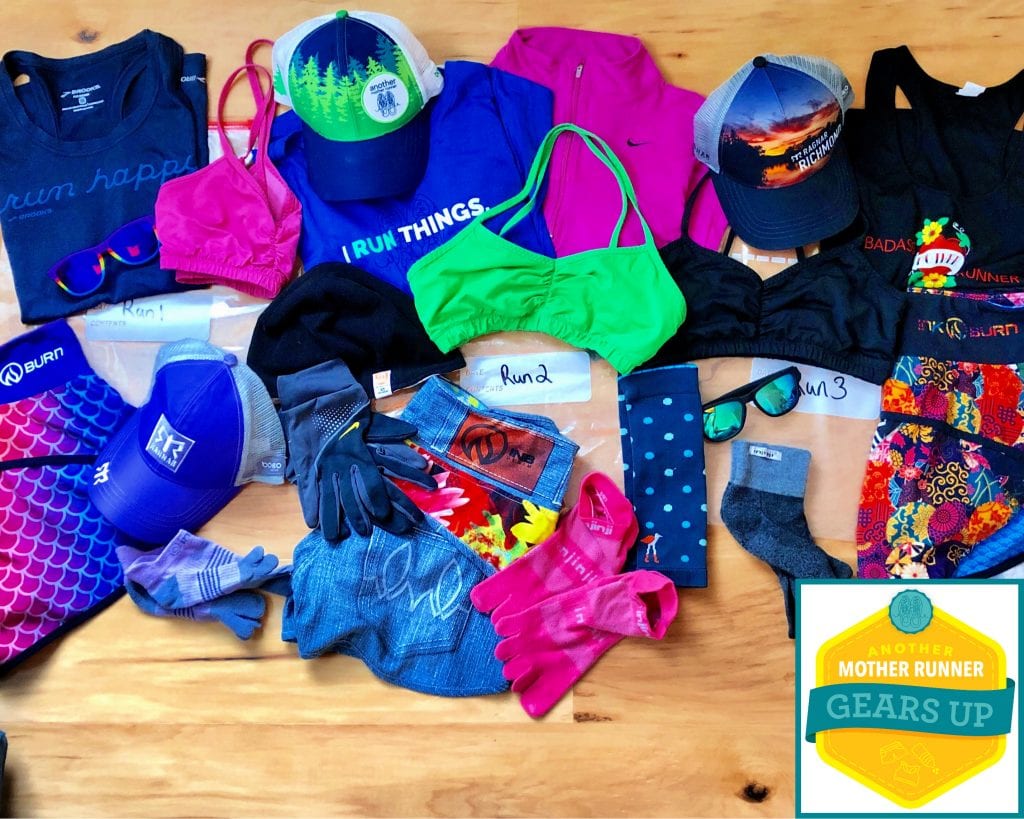
ZIPLOCS UNPACKED
SHOES + SOCKS: ALTRAS + INJIJIS
 POST-RUN CLOTHING
POST-RUN CLOTHING
ORANGE MUD GYM BAG

ESSENTIAL TOILETRIES

HYDRATION PACKS + SPORTS NUTRITION
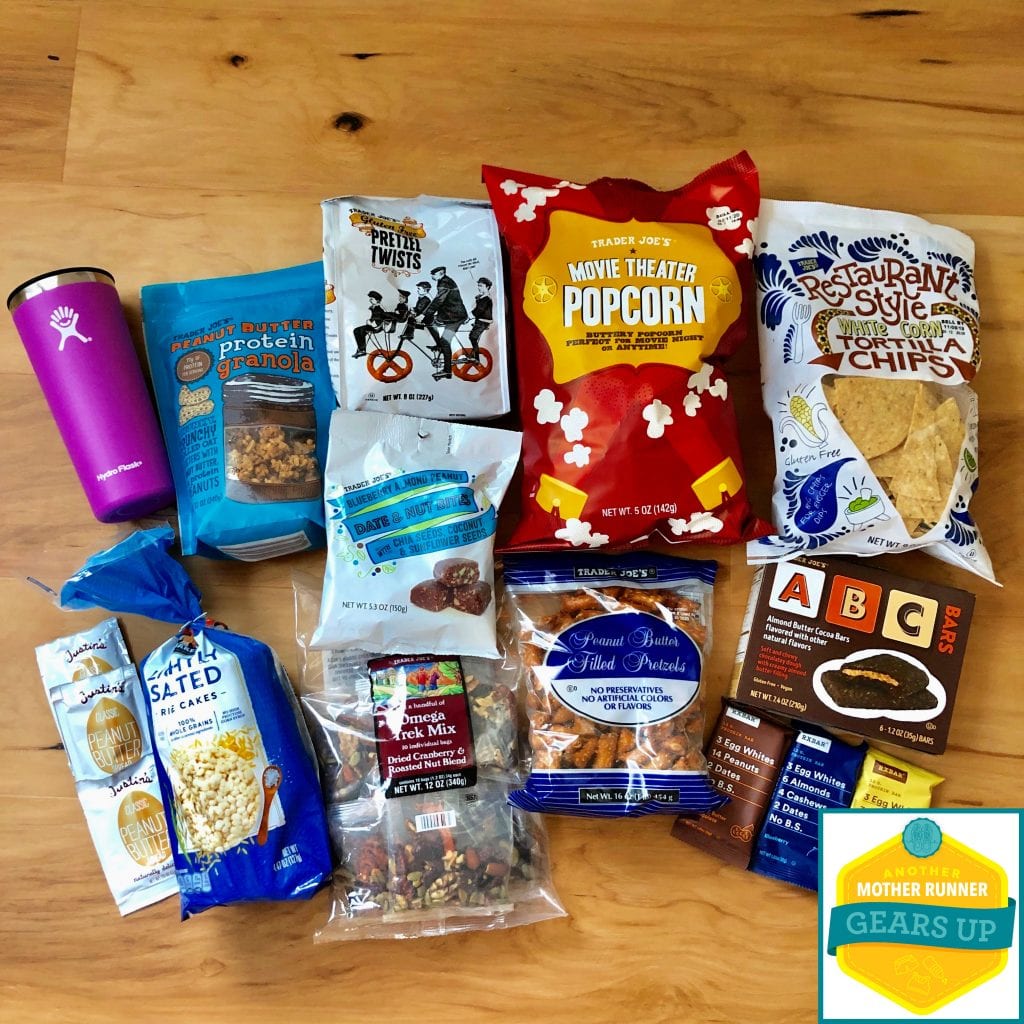
SNACKS FOR THE (LONG) ROAD

LIGHTS + REFLECTIVE GEAR

A TEAM THEME + COSTUME
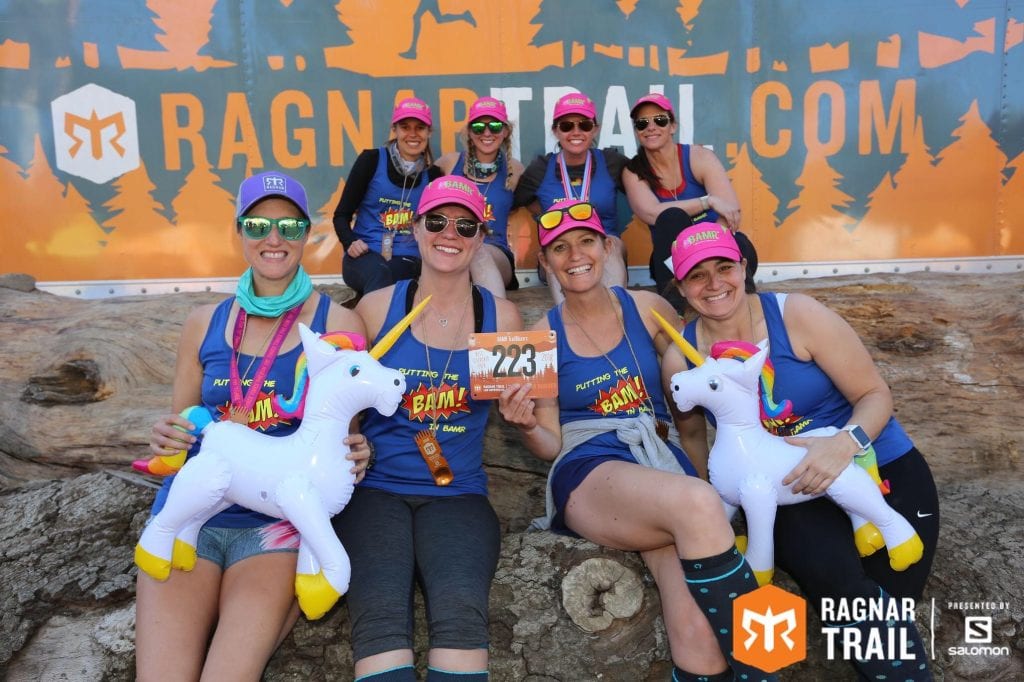
AND THE TEAM…
WHAT RELAY GEAR IS A MUST FOR YOU?
Mother Runner of the Month: Amy Landes
Our Mother Runner of the Month this month is one who has struggled mightily with our sport—and is willing to be open and honest about it.
Amy Landes, a 47-year-old nurse and mother of three (ages 24, 21, and 19) in St. Louis, Missouri, was nominated by her older sister, Melanie.
“In May of 2018, my sister set a new PR in the Illinois Marathon, winning the master’s division in 3:03.35. She was 46,” Melanie writes, “Three months later, she stopped running, and entered recovery for a 15-year eating disorder. She courageously faced her disease—and gave up her beloved activity of running—because she knew she needed to be a mother first, and that continuing her disorder was killing her.
Amy exemplifies courage, strength, and a driving love for her children, making her the #motherrunner I admire most.”
We reached out to Melanie to make sure Amy was ok with talking publically about her illness, and despite a recent relapse, she was.
Before we dive in, we wanted to share this disclaimer from Amy. “Everything I say about Eating Disorders (ED) and recovery here is my story only, and I think a lot can apply with other adults with eating disorders, but I can’t speak with any appropriate knowledge or authority on teens/kids with eating disorders.”

Melanie and Amy, sharing smiles after 2017 Go! St. Louis Marathon.
First Miles: I started running a little bit between my second and third kids, so about 20 years ago. I was mildly interested at the time. My older sister Melanie had been a runner since high school and was training for her first marathon, and a good friend of mine was running. They both seemed to love the sport and encouraged me to join up. I stopped during my pregnancy with #3, and started up again afterward. I ran my first marathon in 2002.
Natural Talent: I think maybe I knew I was a good runner after my first marathon. I finished with a decent time and didn’t feel like it was too hard, so for my second marathon I made a time goal and was able to reach that with relative ease.
Sister Act: When we lived close to each other, Melanie and I did weekend long runs together. It was always an important time to talk about kids, husbands, our parents, work and school.
My favorite race memories are all with Melanie—for a stretch, we ran the Portland Marathon every year—and they all come from AFTER the race instead of during. We didn’t always run it together, so it was always fun to find each other after the race, shivering and hobbling toward each other, and recap the entire 26.2 miles together.
Even if we didn’t race together, I loved sharing the nerves at the starting line together. We ran Boston together the entire time, another great memory (kind of, it was one of those weird years where it was 90 degrees at the start).
We also ran some out-of-the-way marathons together, with little fan and/or course support. One that sticks out was in Olympia, WA, out in the country on Valentine’s Day weekend. We ran together the entire time and both finished feeling fantastic, but there was really no big finish line to celebrate. Instead, just some questionable chili and the ugliest T-shirt you’ve ever seen with weird runner figures and hearts all over it. We got good laughs from that one.
Hollow Accomplishments: I was always elated after a good marathon: a PR, a top-three finish, and a couple of times even a win, but those times were often solo, with no one really there to celebrate with. Those are still good memories of feeling accomplished, but ring somewhat hollow because of my isolation and compromised health during those times.

Hanging with the family in July 2018.
An Unhealthy Connection: My running addiction and eating disorder went hand in hand; as each developed, they became completely intertwined.
I was a completely ‘healthy’ and ‘normal’ runner at the beginning. I ran the number of miles on my training plans and ate to fuel and recover without giving it a second thought. After my second marathon, I realized I was good at this and maybe I’d be even better if I ate ‘like a runner.’
Honestly, I don’t remember thinking I needed to lose weight, I just wanted to train and eat like a good runner. My diet became more rigid and restrictive. I lost weight, my times got even faster. Eventually, I started adding miles here and there as compensation if I felt like I had too many calories or wasn’t strict enough with my eating.
I ran or did some kind of exercise every day of the week (6 days running, 1 day of cross-training), and my daily intake was the exact same every day as well: same breakfast, lunch, snack, dinner. If I wasn’t able to do my regular meal schedule for some reason, I compensated by running more the next day.
Not about the miles: Running favors the lithe and lean. I liked being a good runner and winning races, and I didn’t think that was possible without restricting my eating. However, once the eating disorder and all the habits that go with it were firmly ingrained, I would have found other ways to continue the disorder even if running wasn’t a factor.
So in the depths of the disorder, staying thin and the fear of weight gain were more important to me than running well and a successful running career.
I did not start this process with ‘I think I’ll start having an eating disorder’, but once I was in it, I definitely knew what I was doing and that it wasn’t normal. My sister, my mom, and my husband would say things once in a while as they saw my weight go lower and lower, but I always had excuses and rationalizations for everything. I have learned a lot through recovery, including that recovery has to be my choice and my responsibility, not anyone else’s.
Getting Help, Round I: I decided to attend a treatment center in 2010, was not effective or helpful (as so many ED treatment centers are not, which is a whole other discussion).
Getting Help, Round II: Last summer, a friend of mine guided me to the work of eating disorder recovery coach Tabitha Farrar. Tabitha herself had recovered completely from a long term ED as an adult and so much of her information resonated with me. Tabitha (and others I have discovered) takes a biological view of restrictive eating disorders; Some people have a genetic predisposition to developing an ED that is triggered by a prolonged energy deficit (not taking in as much as you are burning).
What Recovery Looks Like: My focus is on nutritional rehabilitation and neural rewiring for recovery.
Treatment for me has meant reading and listening to a LOT of information and Skype meetings with Tabitha. Basically recovery means eating unrestrictedly (whatever I want, whenever, in any amount) for nutritional rehabilitation and weight restoration.
Yes, this means a lot of weight gain, which is over and above my normal ‘set point’ and will likely for a long period of time. Years of starvation can only be healed by unrestricted eating and weight gain to heal internal damage and restore normal biological processes. (I didn’t have a period for almost 18 years.)
The belief is that once healing has occurred and my body believes I am not going to starve it again, it will let go of the extra stored fat and I will return closer to my set point (weight at which your body naturally wants to be at).
In addition, there is a lot of neural rewiring that has to take place. My ED habits are long-standing. It takes a long time to break them and form new pathways for behavior.
The Hardest Part of Recovery: For me to rest. No running. No walking, cross training, weight lifting. For any normal person exercise is encouraged and rewarded, but for me, right now, they only lead to the perpetuation of my addiction and ED. Not to mention that the number of miles and torture I’ve put my body through over the past years.
I just need rest. The recommendation given to me: At least a year, if not more, of no exercise. If I don’t give it that long, it can turn into a really slippery slope for me. (Relapse, next question!)
Not a Unicorn: I was doing really great with recovery last summer/fall. I was eating unrestrictedly, resting, gaining weight, and I got my period back!
I thought I was the unicorn.
Since I was doing so great, I thought I could start exercising again! False.
I started walking, which quickly turned into running and going to the gym, followed by the whole cascade of food restriction and weight loss.
Reality Check: I should have mentioned before, I was miserable in my ED. I was so tired and so hungry all the time. I had no energy beyond running my miles for the day (which I can’t even fathom how I did that on the amount of food I was eating). My relationship with my husband was tenuous at best: no sex for years will do that. (I had low sex drive due to ED.)
Anyway, I hit that low point again quickly after the few months of relapse and knew I didn’t want that life again, so I recommitted to recovery.

Lovely Wedding Day for Amy’s oldest daughter.
Me, One Year Down the Road: Honestly, a year from now seems a lifetime away. Recovery is a long and very hard process. I don’t mean to make it sound otherwise.
The years of not eating and running are taking a long time to fix. I don’t know who I am without my ED. I don’t know what I like to do, what hobbies I may find interesting, I never found a career path that felt good because all my energy and focus went to maintaining my ED.
I hope during the next year I will find some of those things out.
A Crushing Guilt + a Cushy Lap: I don’t remember what I looked like, and being many sizes bigger is overwhelming. And the guilt that comes with being so focused on my weight and size is crushing, when I know there are SO MANY more important things I could be dedicating my time and energy to.
My kids don’t really know a mom without an eating disorder. My daughter is recently married and excited about starting a family, possibly soon. Her plan is for me to be her childcare provider. I have promised I will be a doting grandma with a soft and cushy lap on which her kids can snuggle.
A Complicated Recovery: If you’re struggling with exercise addition or an eating disorder, the pat answer is, of course, get help.
But I know it’s so much more complicated than that. Recovery is a choice and until one has made that choice and commitment, no amount of ‘help’ will do any good (again, this applies to adults only).
Also, like I said, there are so many ED treatment centers and providers/professionals that actually end up doing more harm than good. I truly believe that full recovery is possible, and I recommend anyone who is contemplating recovery to look up anything by Tabitha Farrar, Kayla Rose Kotecki, Gwyneth Olwyn, Eating Disorder Institute, and the Homeodynamic Recovery Method.
Know somebody (it may be yourself!) that is deserving of the Mother Runner of the Month title?
Submit a nomination!
#381: How to Dig Deep in a Running Race
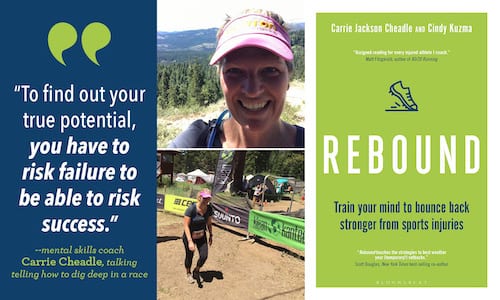
-replacing dread with gratitude at a starting line;
-what grit is—and how to hone it;
-keeping your brain where your feet are in a race;
-the two levels of perceived effort—and how it’s a bit like a hall of mirrors; and
-post-race blues, and how to veer away from them.
In the relatively brief intro chitchat, Sarah shares a story about why she ended up walking barefoot halfway through a trail run. The mental skills advice starts rolling in at 15:10.
Save 30% off Carrie Cheadle’s book Rebound at Bloomsbury.com using code REBOUND
Thanks to Native. Get 20% off your first purchase by going to nativedeodorant.com and entering promo code AMR
Get started today at StitchFix.com/KIDS/AMR to try Stitch Fix with no styling fee and get an extra 25% off when you keep everything in your box!
Thanks, Cove. For a limited time, get your first month of medication free by going to withcove.com/AMR


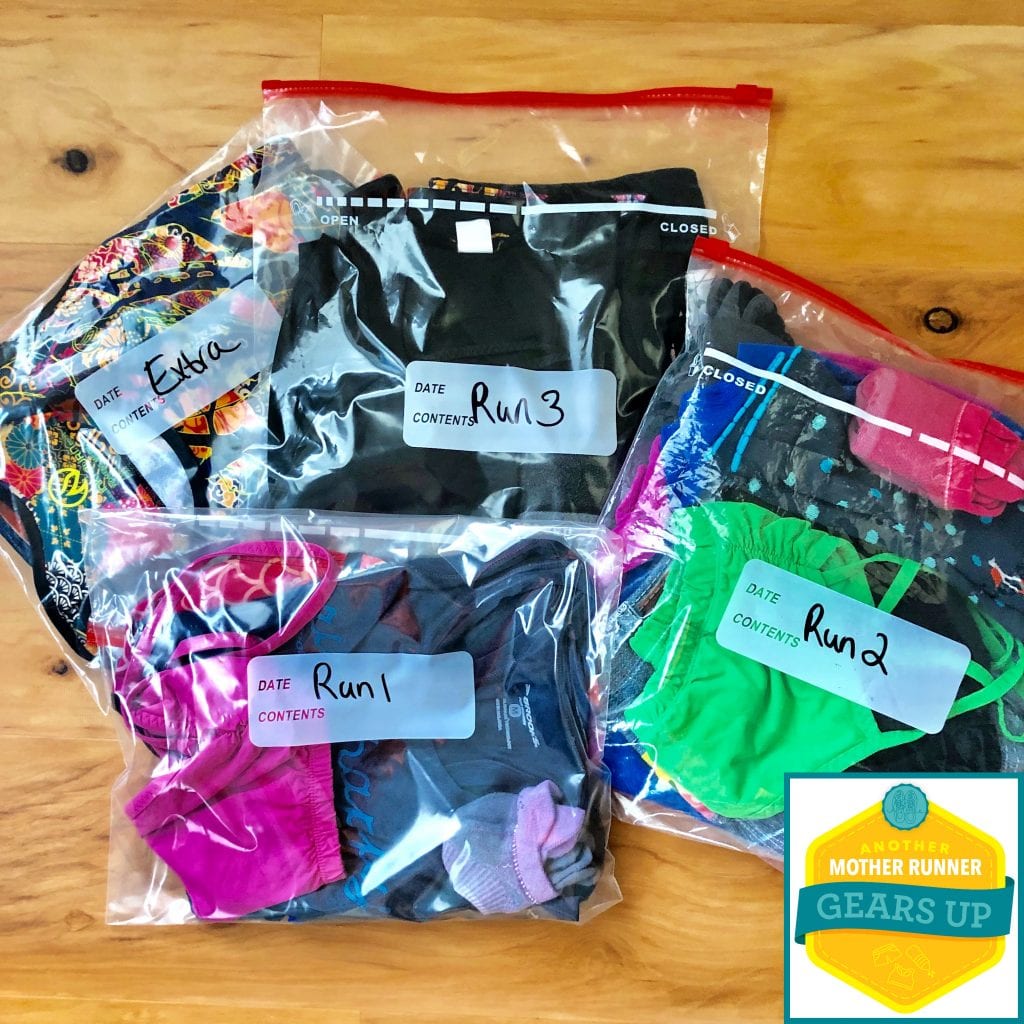 OUTFITS PACKED IN ZIPLOC BAGS
OUTFITS PACKED IN ZIPLOC BAGS
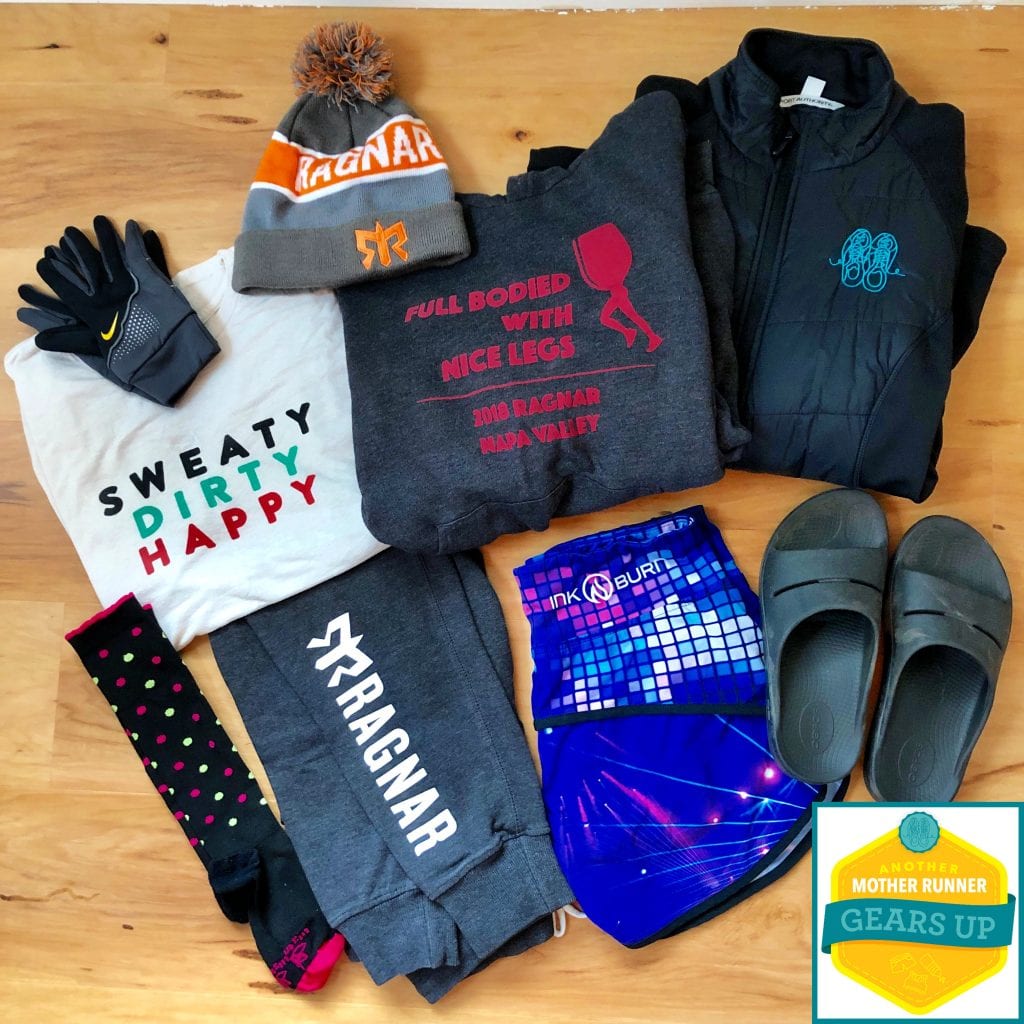 POST-RUN CLOTHING
POST-RUN CLOTHING
